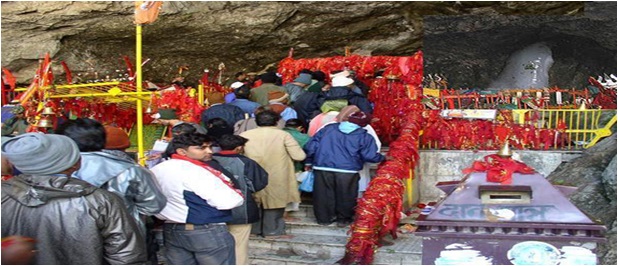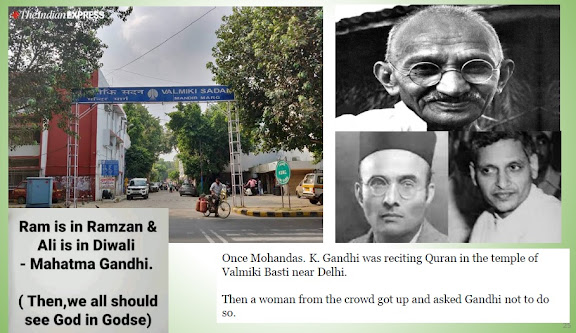Four Mass Participatory Hindu Festivals by Pavithran
Four Important Mass Hindus Participatory Religious Festivals are as under:
•Amarnath Yatra – In 2018, Yatra was extended from last year’s 43 days to 60 days between June 28 and
August 26. The 60-day yatra was concluded on 26 August 2018 coinciding with the 'Raksha Bandhan' festival.
•Palkhi Pandharpur Yatra – From 02-07-2018 to 24-07-2018 –
confined to Maharashtrians
•Kanwad Yatra or Ganga Jal Yatra – From 22-07-2018 to 09-08-2018
•Vinayakar Chaturthi Festival – September 13, 2018.
Important aspects of these four festivals are briefly brought out here.
Amarnath Yatra:
Amarnath Yatra is to have a dharshan of Shiva Linga formed naturally from snow
in Amarnath cave shrine which is
located in Jammu and Kashmir. The cave is situated at an altitude of 3,888
meter (12,750 ft) about 141 km or 88 miles from Srinagar and is to be reached
through Pahalgam town.
The cave is surrounded by
snowy mountains. The cave itself is covered with snow most of the year except
for a short period of time in summer when it is open for pilgrims.
Hundreds of thousands of
Hindu devotees make an annual pilgrimage to the Amarnath cave across challenging mountainous terrain. According to a Hindu religious beliefs,
this is the place where Shiva explained the secret of life and eternity to
his divine consort, Parvati. Climbing up the mountains, battling
ice-cold wind and incessant rain, this year first jatha finally walked up the stairs leading to the Amarnath cave to have the darshan of Snow Shivlinga.
Passport-size photographs, coins and
currency notes were thrown inside the cave enclosure, and the crowd roared when
they spotted a pair of pigeons in this year as well. According to mythology,
there were two pigeons when Shiv told the mantra of becoming immortal
to Parvati at the Amarnath cave.
Fortunately,
this year yatra was incident free and well organized
.
Palkhi Pandharpur Yatra:
It
is one of unique feature of Mahastrian culture which is a 1000 year old tradition followed by
the warkaris individuals. It is a
22 days yatra. There are two main Palki Yaras. One is called Saint
Tukarama Maharaj Palki Yatra from Dehu, Pune and the other
belonging to Saint Dnyaneshwar from Alandi – the two in
Maharashtra. Both will end at famous Vithoba Temple, Pandharpur on Ashadi Ekadashi.
Main Palakhis (palanquin processions) are the padukas (foot prints) of
Saints Tukaram and Dnyaneshwar from their
respective shrines to Pandharpur with chanting of
those saints’ religious songs accompanied with playing tamburas, beating drums,
striking cymbals and dancing all along the 21 days long trip by foot by the
devotees.
Apart from these two main palakhis, numerous such palakhis with padukas from various shrines en route will join along with
devotees accompanying them. This
festival attracts a total of over a million pilgrims.
Kanwar or Kavad Yatra:
An estimated four crore pilgrims called kanwariyas arrived in Haridwar alone this year. The total number of kanwariyas in north India itself would be much more, as Haridwar is not the only place from which to pick up the holy Ganga water. Gaumukh and Gangotri in Uttarakhand are popular and even smaller ghats like Garh Mukteshwar in Uttar Pradesh’s Hapur district attract large crowds.
The history of this auspicious walk is often explained in two mythological stories. In the Hindu Puranas, the Kanwar Yatra is related to the churning of the ocean of milk. As narrated in the Bhagwat Purana, when the poison came out before Amrita, the world started burning from its heat. Lord Shiva consumed the poison to protect the living world. It was so violent that it changed the colour of Shiva’s neck into blue. And to reduce the impact of the poison, Gods and Devas poured Ganga water to Lord Shiva.
The other story is originated to Lord Parashurama, who is popularly known as the firm
devotee of Shiva. Traditionally, it is he who is belived to be the first to undertake the Kanwar Yatra. In Uttar Pradesh’s Pura, he laid the foundation of the
Shiva temple and fetched gangajal every Monday in Saavan worshiping Shiva.
As Shiva’s throat becoming blue in colour, Shiva is worshiped as Neelkanth – meaning blue throat.
Young to old including woman and
sometimes children have started participating in this holy yatra and kanwar mela. On their holy journey, kanwariyas chant “Bol Bam, Bam Bam”, “Bam Bam Bhole”, ‘Har Har Mahadeve’ together. With utmost bhakthi, the Shiv Bhakts visit their respective Shiva
Temples in their localities and perform abhishekams on Shivalingams and thereby ending their virathas.
Vinayaga Chathurthi:
Vinayaga Chathurthi became a major social and public
event with sponsorship of Shivaji Maharaj after Mughal-Maratha wars.
In 1893, Indian freedom figher Lokmanya Tilak expanded Ganesh Chaturthi festival into a mass community even
and a hideen means for political activism, intellectual discourse, poetry recitals,
plays, concerts and folk dances.
This trend had spread to southern
states gradually and now Ganesh Chathurthi becomes a grand mass festical in all the southern states such as
Tamil Nadu, Andhra, Telegana, Karnataka, Goa, Chhattisgarh not
to speak about its birth place of Maharashtra – Gujarat States.
Ganesh Chathurthi is celebration of
birth of Lord Ganesha. It is believed that
once while Parvati was bathing, she
created a human figure from some unguent and balm, gave him life and asked him
to guard the door while she bathed.
After a long
period of meditation on Mountain Kailash (Lord Shiva’s abode), Shiva chose that very moment to drop
by to see his better half, but was abruptly stopped by the man-god Parvati had posted at the
door.
Outraged by the
cheek of this stranger, Shiva cut off his head only to discover moments later that he had killed Parvati’s son! For fear of
enraging his wife, Shiva immediately dispatched his ganas (attendants) to get him the head of
the first living creature they could find. Well, the first living creature
happened to be an elephant. As instructed, the head was chopped off and brought
back to Shiva, who placed it on Parvati’s son’s body, bringing him back to life. This elephant-headed
god was welcomed into the first family of the Hindu heavens and named Ganesha or Ganapati, which literally means the chief of the ganas, or the attendants of Shiva.
Ganesha is also called vigneshwara meaning ‘the cleaner of obsacles’. He is also the God of knowledge and wisdom.
For Hindus, Elephant God Ganesha is the first God to be
invoked in any religious functions and His Blessings are foremost to start so
that entire function will be accomplished without any obstacles.

















Comments